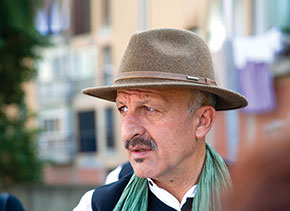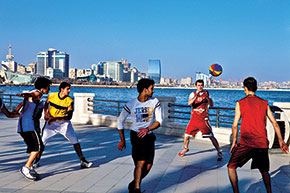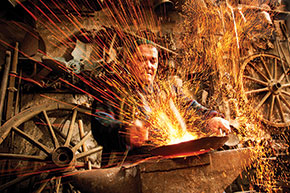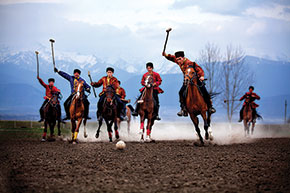Born in Tabriz, Azerbaijani photojournalist Reza Deghati’s latest photography books explore the light and dark of contemporary Azerbaijan. The books were launched at a grand exhibition at the Petit Palais in Paris in November 2014 and serve as a reference about modern Azerbaijani culture and identity. In a recent interview with Visions editor Tom Marsden, Reza spoke in greater depth about his special connection with the country and a quite fascinating career that started almost by chance with the Iranian Revolution in 1979 and continues to lead Reza to all corners of the world.
The truth is that I never intended to become a photojournalist, Reza begins in his usual concise, considered manner. It has taken several weeks and various failed attempts to finally meet him, albeit over Skype, such is the busy schedule of an established National Geographic photographer currently engaged in a five year project photographing and training refugees in Iraqi Kurdistan. In the meantime I have researched Reza’s career, studied his images and leafed through his latest books sponsored by the Heydar Aliyev Foundation: The Elegance of Fire and The Massacre of the Innocents. When we eventually meet I am half way up a ski resort in the French Alps and Reza is in Paris and only has 30 minutes.
Despite at least being in the same time zone, half an hour chatting to Reza can only scratch the surface of a mesmerising career in photojournalism that has encompassed the Iranian Revolution (1979), the Iran-Iraq war (1980-88), the Soviet war in Afghanistan (1979-89), the Rwandan Genocide (1994), the war in Nagorno-Karabakh (ongoing), the Israeli-Palestinian conflict (ongoing) and much more in between. The natural first question is – where did it all begin?
ROOTS
Reza’s is a career that developed through circumstance and might never have been. Despite a passion for photography developed since the age of 13, he went on to study architecture at university in Iran and continued to photograph as a hobby. The turning point came with the Iranian Revolution in 1979 when Reza began documenting events with his camera:
The foreign media was there, they saw my work and in the beginning they didn’t believe that it was mine. They thought it was some professional photographer doing it, that I was just kidding them by showing these pictures and I kept saying ‘no, these are just my pictures.’
Publications such as Newsweek, Time and Paris Match subsequently offered assignments and, ‘little by little,’ Reza drifted towards photojournalism. However, the Iranian Revolution didn’t simply occasion a shift in career; soon after, Reza was forced to leave Iran:
The government, the Islamic Republic, didn’t like my publications, so I had to quit Iran. They had forbidden me to take pictures and to come out of my home with my cameras, so it became quite difficult for me, Reza says.
His final assignment for Newsweek in Iran came in 1981, on the frontlines of the Iran-Iraq war. Reza was hit by shrapnel, injuring his left hand. This offered him a route out of Iran as a war survivor, setting in motion several decades of travelling throughout over 15 countries, photographing assignments as a freelance photojournalist. Reza’s strong English, dotted with isolated Frenchisms and an accent shaded in Azerbaijani, reflects these many years spent abroad.
I settled first in New York because I was working for Newsweek. Then I found out that while I am covering the news I need to be more in Europe and I like Paris more than New York so I came back to Paris where I live now for more than 25 years.
During those 25 years he became a French citizen, continued working for the likes of Time and Life magazines and then National Geographic came knocking in 1991. Reza has been completing assignments for them ever since. Yet, he stresses, he has always remained independent:
Because, you know, there are stories that I want to do on my own, there are places that I want to go, there are moments of history that I want to be there for when they are happening and if you’re employed then you have to get the approval of your magazine or your editors to go there.
ON ASSIGNMENT IN AZERBAIJAN
Reza’s latest books – The Elegance of Fire and The Massacre of the Innocents – are two utterly contrasting collections of his work dealing with Azerbaijan, a country that has clearly been such a focus of Reza’s attention that I wondered what is his special connection with the country? The answer, on the one hand, is simple - Well the reality is that I am Azerbaijani.
Reza is originally from Tabriz and his parents from Ardabil, both regions in northern Iran populated by Azerbaijanis, who, like Reza, consider them parts of Southern Azerbaijan:
These places like Baku, Ardabil and Tabriz are really the heart of what you call Azerbaijan, it doesn’t matter that some parts are in Iran and some in Azerbaijan. For us Azerbaijanis we are all one nation, one people, there is no difference between us.
But history too has repeatedly brought Reza to Azerbaijan. He describes feeling ‘disturbed’ during his first visit to Baku in 1987 due to the enormous gap between the reality he witnessed and the expectations generated by years of Soviet propaganda, painting Soviet Azerbaijan as a paradise. In reality Baku was a rotten, black city, dark, and the people were very poor, he says.
Nonetheless his book, The Massacre of the Innocents, which portrays Azerbaijan during those dark years of the Soviet era and the turbulent 1990s, also describes the warm hospitality and connection with the Azerbaijani people that Reza experienced during those few important weeks in 1987, during which he made his first images of Azerbaijan.
Fate would bring Reza back a few years later, on a very different type of mission. The date was 20 January 1990 and Soviet tanks had reportedly just rolled over demonstrators in Baku. Reza’s subsequent images of the ensuing days are deeply traumatic but more striking still is the audacity of this trip, which involved faking an assignment to Moscow, sneaking into occupied Baku on the train and remaining hidden in various apartments, hospitals, morgues and cars. Reza recalls:
I immediately jumped on a plane to Moscow to follow a friend of mine, a cameraman for French TV, and a few other people who were travelling. And then from Moscow we had to hide in a train to get to Baku. It was the only way because the Russians had circled the city. The Russian soldiers were everywhere. They had killed hundreds of people, a few hundred were wounded and I got pictures of people in the morgues afterwards - people coming and looking for the bodies of the dead, pictures of the families.
The resulting images and footage were distributed throughout the world and informed people about the event that came to be known as Black January. This is the kind of work that as a journalist you have to do, Reza reflects.
In a similarly calm, thoughtful tone, Reza describes hearing the news of the Khojaly massacre in 1992 and once again making the trip ‘immediately’ from Paris to Baku. There he made contact with Médecins du Monde and Pharmaciens Sans Frontières and travelled with them towards Karabakh, to Agdam:
That’s where we saw all these people bringing dead bodies, and they were killed in a very terrible way – mutilated.
The images in The Massacre of the Innocents bear witness to this. The pages are hard to turn. The trauma runs right to the core. I found myself reduced to silence looking at the images, shocked that humans could do this to one another.
In the wake of Khojaly, Reza continued travelling around Karabakh. He entered Shusha on foot through the mountains and photographed the city under siege, surrounded by Armenian troops. These were the last moments before the Armenian attack, which would reduce much of the city to ruins. Reza had previously spoken about the importance of remaining objective as a photojournalist, but I wondered, amidst all the bloodshed, how he coped with this in Karabakh?
Generally, Reza responds, he would try to photograph both sides of a conflict, for example the Israelis and the Palestinians, the Hutus and the Tutsis (during the Rwandan Genocide). During those conflicts he would photograph one side and then move to the other:
But the truth is that when I was photographing the Karabakh story I tried by all means to go to the other side to take photographs, but I was refused entry. I even tried to use Red Cross cover and travel with them to the region but the Red Cross also told me they were afraid they couldn’t guarantee our security because of my origins.
Following Karabakh, Reza describes his attention turning to the consequences of the war and in particular the resulting refugee crisis, stressing the hardship of the 1990s in Azerbaijan:
The people of Azerbaijan themselves were poor but they also had one million refugees arriving. So 1992, ‘93, ‘94, ‘95 were really very, very tough times. You were seeing a lot of hungry people on the streets in Baku. For many of the foreigners who come to Baku now, when I say this they don’t believe me.
The IDPs (Internally Displaced Persons) form a major subject of The Massacre of the Innocents, in which Reza’s quiet images portray their makeshift lives formed of corrugated huts and scraping by on the margins of suburban post-Soviet Baku. Later that decade, Reza’s final assignment was to photograph a story about the Caspian Sea for National Geographic magazine. Several of those images are also presented in The Massacre of the Innocents.
THE ELEGANCE OF FIRE
More recently, in 2011, Reza was invited by the Heydar Aliyev Foundation to work on a very different portrayal of Azerbaijan. The Elegance of Fire focuses on the colourful, ancient traditions, lush landscapes and multi-national make-up of contemporary Azerbaijan. The photographs in the book were taken during roughly 15 trips over three years, during which Reza travelled throughout Azerbaijan’s regions, witnessing a diverse collection of events, moments and peoples. The images, accompanied by verses from prominent Azerbaijani poets, highlight Azerbaijan’s ethnic, cultural and culinary diversity and Reza believes he hasn’t missed a beat:
I believe that for the people who know Azerbaijan well, everything about Azerbaijan is there: the food, the culture, sport, faces, ethnicities, different landscapes and religions.
Reza’s books couldn’t be more contrasting, yet they are almost equally engaging, touching and revealing of the Azerbaijani national spirit. He describes the two books as:
Like a testimony, like a reference about Azerbaijan, so whoever wants to know what Azerbaijan is and what’s happened over the past few decades, the history of Azerbaijan, I believe and hope that these two books will have this information.
More than anything, however, Reza’s photographs in The Elegance of Fire and The Massacre of the Innocents are, as he describes, a continuation of my philosophy of life, which is that life is beautiful and that humans are beautiful. Yet the images also bear witness to the immense suffering experienced during wars, famine and displacement; the overall message being –
Look what can happen if we don’t take care of it, if we keep making wars, if we don’t try to bring peace to this place.
FUTURE PROJECTS
Reza continues to work in regions torn apart by war. He is currently partnering the UN Refugee Agency, working voluntarily to train young refugees in Iraqi Kurdistan to become refugee camp photographers and reporters. He is also working on a long-term project photographing refugees and internally displaced people throughout the world called Exile Voices. Yet, despite his continued work covering war and its consequences, Reza has always been and continues to be, as he describes, more a correspondent of peace than of war.
The Massacre of the Innocents and The Elegance of Fire can be purchased by contacting Reza’s office directly by email at info@webistan.com
The truth is that I never intended to become a photojournalist, Reza begins in his usual concise, considered manner. It has taken several weeks and various failed attempts to finally meet him, albeit over Skype, such is the busy schedule of an established National Geographic photographer currently engaged in a five year project photographing and training refugees in Iraqi Kurdistan. In the meantime I have researched Reza’s career, studied his images and leafed through his latest books sponsored by the Heydar Aliyev Foundation: The Elegance of Fire and The Massacre of the Innocents. When we eventually meet I am half way up a ski resort in the French Alps and Reza is in Paris and only has 30 minutes.
Despite at least being in the same time zone, half an hour chatting to Reza can only scratch the surface of a mesmerising career in photojournalism that has encompassed the Iranian Revolution (1979), the Iran-Iraq war (1980-88), the Soviet war in Afghanistan (1979-89), the Rwandan Genocide (1994), the war in Nagorno-Karabakh (ongoing), the Israeli-Palestinian conflict (ongoing) and much more in between. The natural first question is – where did it all begin?
ROOTS
Reza’s is a career that developed through circumstance and might never have been. Despite a passion for photography developed since the age of 13, he went on to study architecture at university in Iran and continued to photograph as a hobby. The turning point came with the Iranian Revolution in 1979 when Reza began documenting events with his camera:
The foreign media was there, they saw my work and in the beginning they didn’t believe that it was mine. They thought it was some professional photographer doing it, that I was just kidding them by showing these pictures and I kept saying ‘no, these are just my pictures.’
Publications such as Newsweek, Time and Paris Match subsequently offered assignments and, ‘little by little,’ Reza drifted towards photojournalism. However, the Iranian Revolution didn’t simply occasion a shift in career; soon after, Reza was forced to leave Iran:
The government, the Islamic Republic, didn’t like my publications, so I had to quit Iran. They had forbidden me to take pictures and to come out of my home with my cameras, so it became quite difficult for me, Reza says.
His final assignment for Newsweek in Iran came in 1981, on the frontlines of the Iran-Iraq war. Reza was hit by shrapnel, injuring his left hand. This offered him a route out of Iran as a war survivor, setting in motion several decades of travelling throughout over 15 countries, photographing assignments as a freelance photojournalist. Reza’s strong English, dotted with isolated Frenchisms and an accent shaded in Azerbaijani, reflects these many years spent abroad.
I settled first in New York because I was working for Newsweek. Then I found out that while I am covering the news I need to be more in Europe and I like Paris more than New York so I came back to Paris where I live now for more than 25 years.
During those 25 years he became a French citizen, continued working for the likes of Time and Life magazines and then National Geographic came knocking in 1991. Reza has been completing assignments for them ever since. Yet, he stresses, he has always remained independent:
Because, you know, there are stories that I want to do on my own, there are places that I want to go, there are moments of history that I want to be there for when they are happening and if you’re employed then you have to get the approval of your magazine or your editors to go there.
ON ASSIGNMENT IN AZERBAIJAN
Reza’s latest books – The Elegance of Fire and The Massacre of the Innocents – are two utterly contrasting collections of his work dealing with Azerbaijan, a country that has clearly been such a focus of Reza’s attention that I wondered what is his special connection with the country? The answer, on the one hand, is simple - Well the reality is that I am Azerbaijani.
Reza is originally from Tabriz and his parents from Ardabil, both regions in northern Iran populated by Azerbaijanis, who, like Reza, consider them parts of Southern Azerbaijan:
These places like Baku, Ardabil and Tabriz are really the heart of what you call Azerbaijan, it doesn’t matter that some parts are in Iran and some in Azerbaijan. For us Azerbaijanis we are all one nation, one people, there is no difference between us.
But history too has repeatedly brought Reza to Azerbaijan. He describes feeling ‘disturbed’ during his first visit to Baku in 1987 due to the enormous gap between the reality he witnessed and the expectations generated by years of Soviet propaganda, painting Soviet Azerbaijan as a paradise. In reality Baku was a rotten, black city, dark, and the people were very poor, he says.
Nonetheless his book, The Massacre of the Innocents, which portrays Azerbaijan during those dark years of the Soviet era and the turbulent 1990s, also describes the warm hospitality and connection with the Azerbaijani people that Reza experienced during those few important weeks in 1987, during which he made his first images of Azerbaijan.
Fate would bring Reza back a few years later, on a very different type of mission. The date was 20 January 1990 and Soviet tanks had reportedly just rolled over demonstrators in Baku. Reza’s subsequent images of the ensuing days are deeply traumatic but more striking still is the audacity of this trip, which involved faking an assignment to Moscow, sneaking into occupied Baku on the train and remaining hidden in various apartments, hospitals, morgues and cars. Reza recalls:
I immediately jumped on a plane to Moscow to follow a friend of mine, a cameraman for French TV, and a few other people who were travelling. And then from Moscow we had to hide in a train to get to Baku. It was the only way because the Russians had circled the city. The Russian soldiers were everywhere. They had killed hundreds of people, a few hundred were wounded and I got pictures of people in the morgues afterwards - people coming and looking for the bodies of the dead, pictures of the families.
The resulting images and footage were distributed throughout the world and informed people about the event that came to be known as Black January. This is the kind of work that as a journalist you have to do, Reza reflects.
In a similarly calm, thoughtful tone, Reza describes hearing the news of the Khojaly massacre in 1992 and once again making the trip ‘immediately’ from Paris to Baku. There he made contact with Médecins du Monde and Pharmaciens Sans Frontières and travelled with them towards Karabakh, to Agdam:
That’s where we saw all these people bringing dead bodies, and they were killed in a very terrible way – mutilated.
The images in The Massacre of the Innocents bear witness to this. The pages are hard to turn. The trauma runs right to the core. I found myself reduced to silence looking at the images, shocked that humans could do this to one another.
In the wake of Khojaly, Reza continued travelling around Karabakh. He entered Shusha on foot through the mountains and photographed the city under siege, surrounded by Armenian troops. These were the last moments before the Armenian attack, which would reduce much of the city to ruins. Reza had previously spoken about the importance of remaining objective as a photojournalist, but I wondered, amidst all the bloodshed, how he coped with this in Karabakh?
Generally, Reza responds, he would try to photograph both sides of a conflict, for example the Israelis and the Palestinians, the Hutus and the Tutsis (during the Rwandan Genocide). During those conflicts he would photograph one side and then move to the other:
But the truth is that when I was photographing the Karabakh story I tried by all means to go to the other side to take photographs, but I was refused entry. I even tried to use Red Cross cover and travel with them to the region but the Red Cross also told me they were afraid they couldn’t guarantee our security because of my origins.
Following Karabakh, Reza describes his attention turning to the consequences of the war and in particular the resulting refugee crisis, stressing the hardship of the 1990s in Azerbaijan:
The people of Azerbaijan themselves were poor but they also had one million refugees arriving. So 1992, ‘93, ‘94, ‘95 were really very, very tough times. You were seeing a lot of hungry people on the streets in Baku. For many of the foreigners who come to Baku now, when I say this they don’t believe me.
The IDPs (Internally Displaced Persons) form a major subject of The Massacre of the Innocents, in which Reza’s quiet images portray their makeshift lives formed of corrugated huts and scraping by on the margins of suburban post-Soviet Baku. Later that decade, Reza’s final assignment was to photograph a story about the Caspian Sea for National Geographic magazine. Several of those images are also presented in The Massacre of the Innocents.
THE ELEGANCE OF FIRE
More recently, in 2011, Reza was invited by the Heydar Aliyev Foundation to work on a very different portrayal of Azerbaijan. The Elegance of Fire focuses on the colourful, ancient traditions, lush landscapes and multi-national make-up of contemporary Azerbaijan. The photographs in the book were taken during roughly 15 trips over three years, during which Reza travelled throughout Azerbaijan’s regions, witnessing a diverse collection of events, moments and peoples. The images, accompanied by verses from prominent Azerbaijani poets, highlight Azerbaijan’s ethnic, cultural and culinary diversity and Reza believes he hasn’t missed a beat:
I believe that for the people who know Azerbaijan well, everything about Azerbaijan is there: the food, the culture, sport, faces, ethnicities, different landscapes and religions.
Reza’s books couldn’t be more contrasting, yet they are almost equally engaging, touching and revealing of the Azerbaijani national spirit. He describes the two books as:
Like a testimony, like a reference about Azerbaijan, so whoever wants to know what Azerbaijan is and what’s happened over the past few decades, the history of Azerbaijan, I believe and hope that these two books will have this information.
More than anything, however, Reza’s photographs in The Elegance of Fire and The Massacre of the Innocents are, as he describes, a continuation of my philosophy of life, which is that life is beautiful and that humans are beautiful. Yet the images also bear witness to the immense suffering experienced during wars, famine and displacement; the overall message being –
Look what can happen if we don’t take care of it, if we keep making wars, if we don’t try to bring peace to this place.
FUTURE PROJECTS
Reza continues to work in regions torn apart by war. He is currently partnering the UN Refugee Agency, working voluntarily to train young refugees in Iraqi Kurdistan to become refugee camp photographers and reporters. He is also working on a long-term project photographing refugees and internally displaced people throughout the world called Exile Voices. Yet, despite his continued work covering war and its consequences, Reza has always been and continues to be, as he describes, more a correspondent of peace than of war.
The Massacre of the Innocents and The Elegance of Fire can be purchased by contacting Reza’s office directly by email at info@webistan.com






